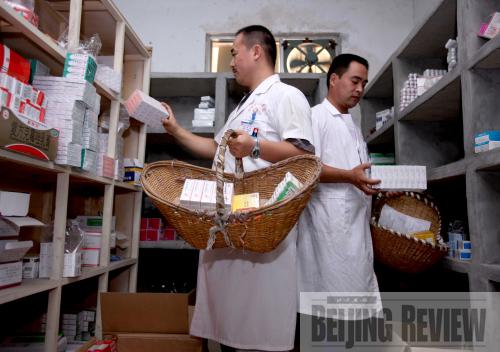|
 |
|
BETTER HEALTHCARE: Doctors at the Tangfang Health Center in Gaoqing County, Shandong Province, prepare medicine for farmers. The new healthcare system in rural areas brings convenience to farmers (CHEN JIANLI) |
In 2008, farmers' annual per-capita net income increased to 4,700 yuan ($688), up 8 percent from the previous year.
In October of the same year, a new standard to classify poverty-stricken population was introduced during the Third Plenary Session of the 17th Communist Party of China (CPC) Central Committee, which focused on rural reform and development.
Officials defined an annual income of less than 786 yuan ($115) as absolute poverty, which had already existed, and an annual income of between 786 and 1,067 yuan ($156) as low income.
Fan said the government has since stopped using the much lower absolute poverty line and now uses only the low-income measure, sometimes called the relative poverty line, as the only yardstick to gauge poverty. Those falling in that bracket are covered by the country's poverty-relief program.
The expansion ensured that 43.2 million rural residents would benefit from poverty-relief policies, accounting for 4.6 percent of the country's total rural population, Fan said.
The annual poverty-relief fund from the central budget increased to 16.7 billion yuan ($2.45 billion) in 2008, 2.3 billion yuan ($336.75 million) more than that allocated in 2007, he said.
New strategy
"Measured by the new standard, the number of poor still remains high in China," said Li of China Agricultural University.
The government renewed its fight against poverty under the changing situation, said Li. He said new challenges include growing income inequality, an increasingly dispersed poor population and large numbers of migrant population in cities.
He said that the new 2010-20 poverty alleviation strategy would be multifaceted because there are many types of poor people in China, but sustained economic growth would always be the key to solving the problem.
"The robust economic growth has always played the most important role in poverty alleviation in the past and it will continue to be the most important one in the future," said Li. He suggested further improving the development of small and medium-sized enterprises, especially township and village enterprises, to employ more rural laborers.
"Increasing the productivity of labor and the access of the poor to work opportunities are the two effective ways to raise the incomes of rural residents," Li said.
Education and vocational training could improve the productivity of labor, he said, but the most important way is to encourage poor residents to better themselves.
"The new strategy will put more emphasis on helping those rural residents living in poverty," he said.
Social security is another emphasis of the new strategy, said Li.
"Strengthening the social security system must become an important part of the overall poverty reduction agenda," he said.
In recent years, China has made significant progress by extending its minimum living allowance program to rural as well as urban areas and investing heavily to expand health insurance coverage, he said.
However, much work remains to be done to strengthen these programs and to make them more transparent, better integrated and more equitable, he said. Social insurance, including unemployment insurance, health insurance and pension coverage, need to be extended to migrants and other workers employed in rapidly growing private economy, he said.
"The new strategy will cover all these questions," said Li.
The National Development and Reform Commission, the top economic planner, has worked out a plan that will create a "safe, effective, convenient and affordable" healthcare system for all urban and rural residents by 2020.
Another reality is that the remaining poor population are in some areas dispersed rather than centralized. "The strategy should be targeted at the household level rather than at the regional level," said Li.
Regionally targeted approaches to poverty reduction were the main focus of government programs in the past. Today, those methods are insufficient for those living in villages not targeted by the programs.
"The reasons for poverty may vary from individual to individual," said Li. "Most of the poor are not chronically so, rather they move in and out of poverty from year to year depending on changes in their health, the weather and their employment situation."
According to Li, the designation of poverty-stricken counties was once based on poor groups of people that gathered in one place. The situation has changed, and a new approach must be taken, he said.
The government labeled 148,000 villages around the country as high-poverty. "Poverty-stricken villages were a more effective designation than poverty-stricken counties. They reflected the reality of poor populations gathered in villages," said Li.
"However, with extensive studies, we find that the poor are not in fact living in same villages but scattering in zones formed by special reasons, such as an earthquake, flood or drought. Sichuan's Wenchuan Earthquake formed a special poverty-stricken zone," he said. "Hence a household-level targeting mechanism would be more reasonable."
"The poverty line designation is not reasonable either," he said. Due to differences in infrastructure, education and healthcare between different regions, the poverty line will lose its real sense. "In some places, people with income under 1,067 yuan ($156) may not feel poor because they have good education and healthcare benefits," said Li.
He said the new strategy would encourage creating different standards in different regions according to real conditions.
"The most important reform in the new strategy will be giving rights to the poor," said Li. In the last 10 years, government officials and the poor themselves have gained experience fighting against poverty. The poverty alleviation departments of Sichuan, Yunnan, Gansu, Guangxi and Jiangxi have found an effective way to solve the problem by giving rights to the poor.
"Based on that experience, the new strategy will further explore how to empower the poor. Then the Central Government can spread the poverty alleviation method to more poverty-stricken areas and families," he said. | 
